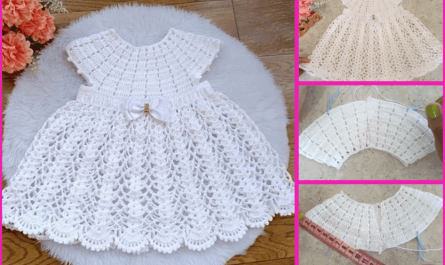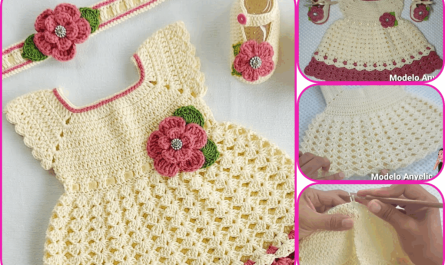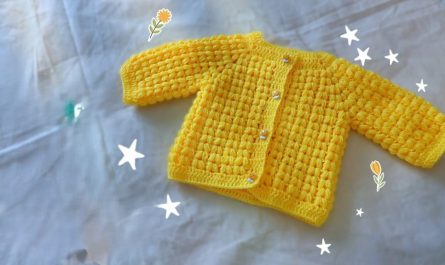There’s something incredibly special about crocheting for the tiniest of loved ones. A handmade baby dress, especially for a 0-3 month old, is a heartfelt gift that’s quick to create and becomes a treasured keepsake. Imagine a little one wearing this sweet dress, perfect for the warm climate of Phnom Penh!
This detailed, step-by-step tutorial will guide you through crocheting a charming baby dress. We’ll use a top-down, seamless construction, which means less sewing at the end – a bonus for any busy crafter!
1. Planning Your Sweet Baby Dress: Key Decisions
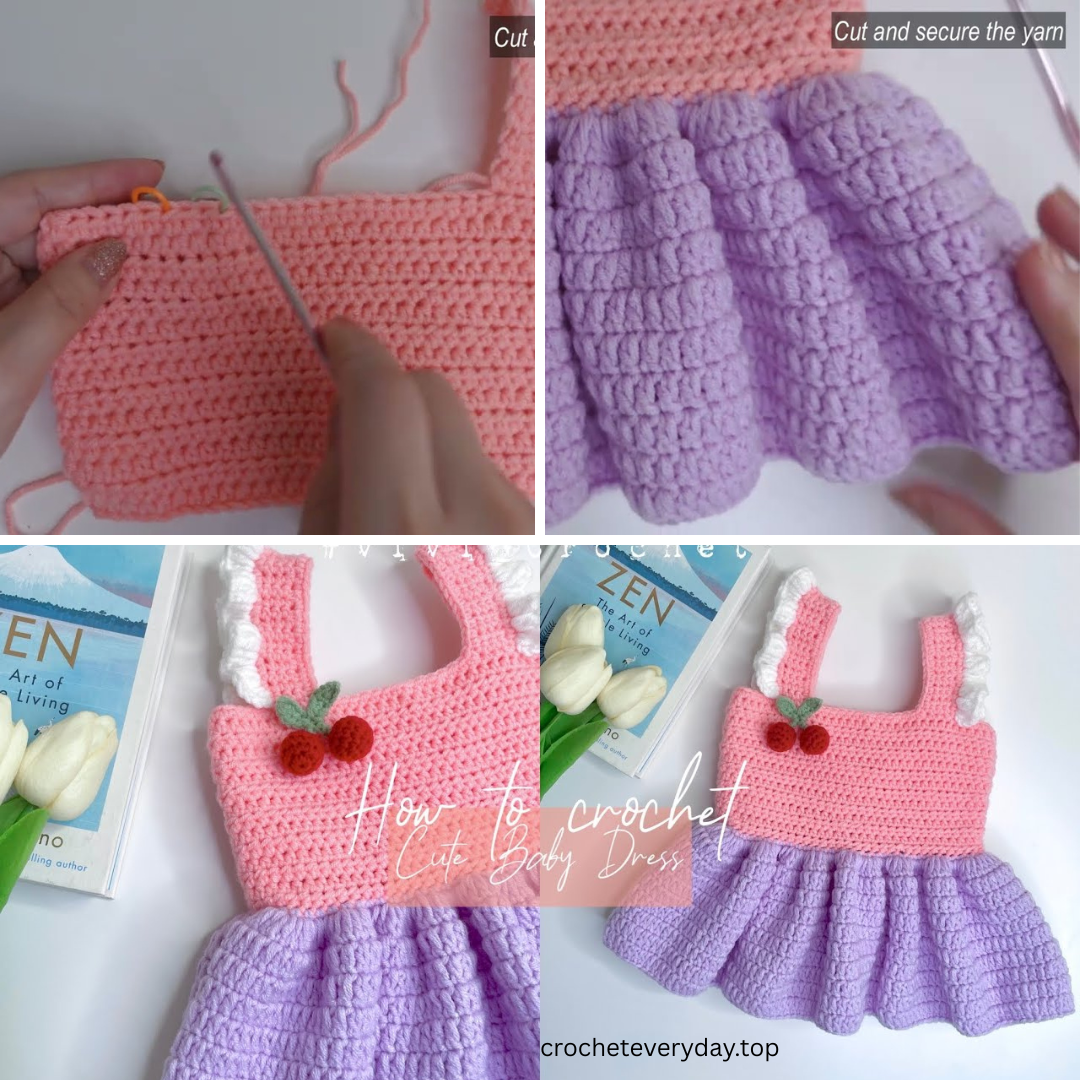
A little thoughtful planning goes a long way to ensure a smooth project and a beautiful result.
- Choose Your Yarn Wisely: For baby items, softness and washability are your top priorities.
- Fiber: Baby acrylic yarn is super popular for its softness, durability, and easy care. Baby cotton or bamboo blends are fantastic choices for their breathability, which is especially important in warmer climates. Try to avoid scratchy fibers.
- Weight: DK (Double Knitting, Category 3) or Light Worsted (Category 3/4) weight yarn works best. It’s substantial enough to work up quickly but isn’t too bulky for a tiny dress.
- Color: Think sweet and cheerful! Classic baby pastels (pinks, blues, yellows, greens, white) are always lovely. You could also choose a vibrant solid or a variegated yarn for an easy multi-color effect.
- Pick Your Hook Size: Always check your yarn label for the recommended hook size. For this pattern, a 4.0mm (G/6) hook is usually a good fit for DK weight yarn, ensuring a nice, soft drape. You might need to adjust up or down a size based on your personal tension.
- Stitch Pattern: Simple stitches are ideal for baby garments. This tutorial primarily uses Double Crochet (dc) for the main body because it’s fast and creates a lovely, soft fabric.
2. Gather Your Essentials: Materials and Tools

Make sure you have everything ready before you start crocheting.
- Yarn: Approximately 100-150 yards (90-135 meters) of your chosen baby yarn.
- Crochet Hook: The size that matches your yarn and desired tension (e.g., 4.0mm / G/6).
- Stitch Markers: These are truly essential for marking increase points and the start of rounds – they’ll save you headaches!
- Tapestry Needle: For neatly weaving in all those yarn ends.
- Scissors.
- Small Buttons: 2-3 small, flat buttons (around 0.5 inches or 1.25 cm) for the back closure.
3. Understanding the Top-Down Construction (Yoke First!)
This dress is worked from the yoke downwards. The yoke is the upper part that covers the shoulders and chest. It’s worked flat initially to create a back opening, then joined to work in the round for the skirt. This method means you’ll have no major seaming to do on the body of the dress!
Approximate Size for 0-3 Months:
- Chest Circumference: Around 16-17 inches (40.5-43 cm)
- Yoke Depth (from neck to underarm): Approximately 4-4.5 inches (10-11.5 cm)
- Total Dress Length (shoulder to hem): Roughly 9-11 inches (23-28 cm)
4. Let’s Crochet! Step-by-Step Tutorial
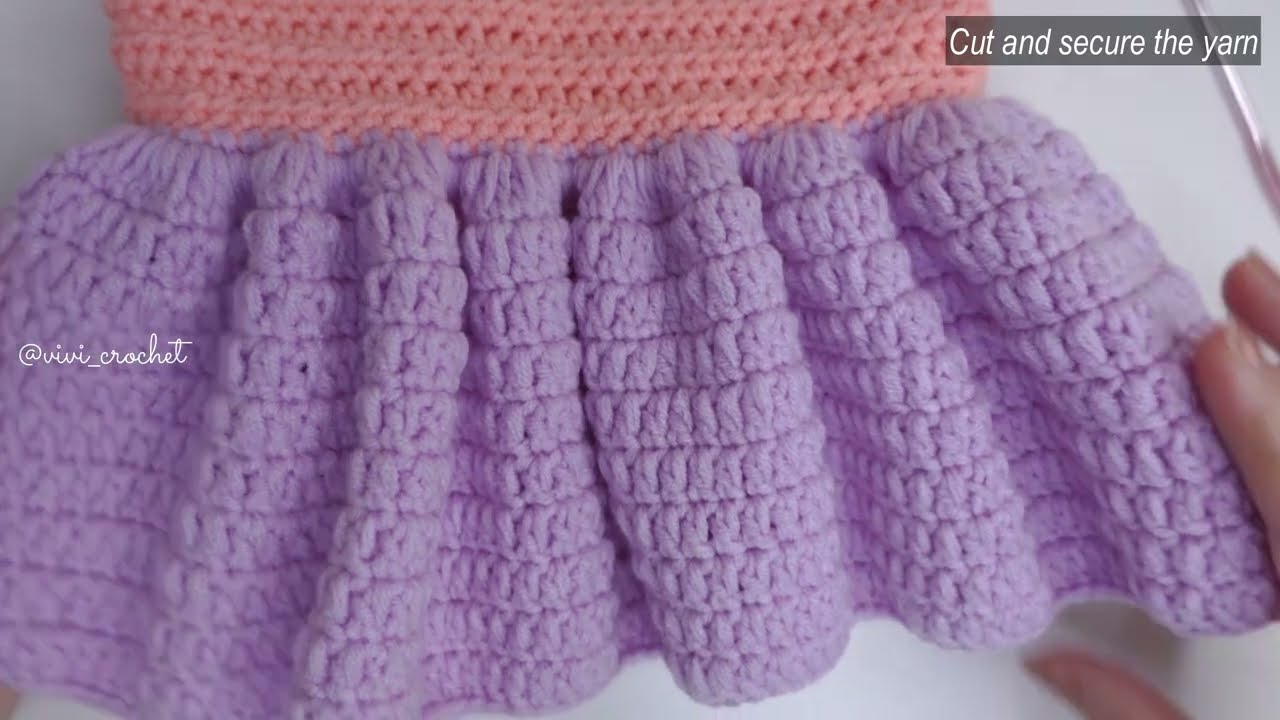
Time to bring your sweet baby dress to life!
Abbreviations You’ll See:
- ch: chain
- sl st: slip stitch
- sc: single crochet
- dc: double crochet
- sk: skip
- st(s): stitch(es)
- sp: space
- inc: increase (work 2 or more stitches in the same stitch/space)
- (): repeat instructions within parentheses
- *: repeat instructions between asterisks
Part 1: The Yoke (Worked Flat)
The starting chain should loosely fit around the baby’s neck. A chain of 52 stitches is a good starting point for 0-3 months.
Chain 52.
Row 1: Dc in the 3rd ch from hook and in each ch across. (50 dc). Ch 2, turn. (The skipped 2 chains count as your first dc).
Row 2 (Increase Row – Shaping the Yoke): You’ll create 4 corner increases for the shoulders and back.
- Dc in the first 7 sts.
- (1 dc, ch 1, 1 dc) in the next st. [Place a stitch marker in this ch-1 sp]
- Dc in the next 9 sts.
- (1 dc, ch 1, 1 dc) in the next st. [Place a stitch marker in this ch-1 sp]
- Dc in the next 16 sts.
- (1 dc, ch 1, 1 dc) in the next st. [Place a stitch marker in this ch-1 sp]
- Dc in the next 9 sts.
- (1 dc, ch 1, 1 dc) in the next st. [Place a stitch marker in this ch-1 sp]
- Dc in the last 7 sts. Ch 2, turn. (You should now have 58 dc, plus the 4 ch-1 sps).
Row 3:
- Dc in each dc up to your first ch-1 sp.
- (1 dc, ch 1, 1 dc) in the ch-1 sp. [Move your stitch marker to the new ch-1 sp]
- *Dc in each dc up to the next ch-1 sp. (1 dc, ch 1, 1 dc) in the ch-1 sp. [Move your stitch marker]*
- Repeat * to * 2 more times.
- Dc in each remaining dc to the end of the row. Ch 2, turn. (You’ll have 66 dc, plus 4 ch-1 sps).
Row 4 – 6: Repeat Row 3. (After completing Row 6, your yoke will have noticeably grown. It should measure approximately 4 inches from the neck edge at the deepest point when measured flat. If your baby is larger, or if your tension is tight, you can add one more repeat of Row 3.)
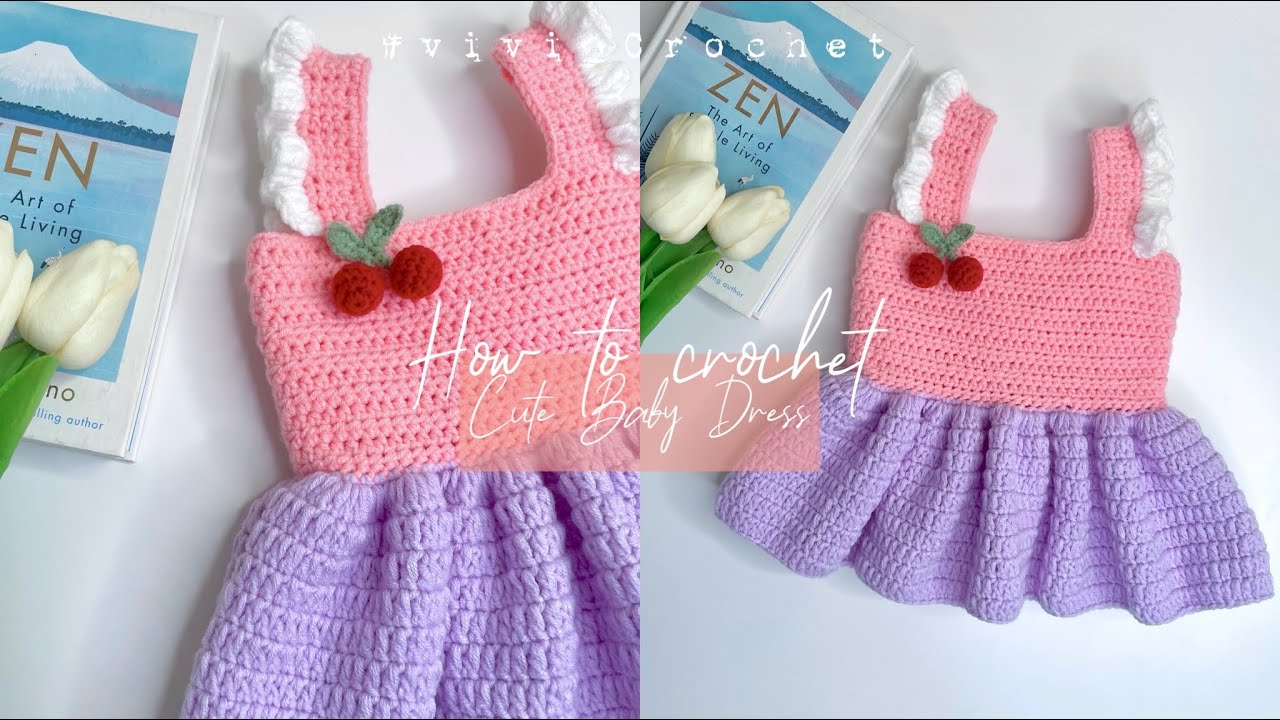
Part 2: Dividing for Body & Sleeves (Joining to Work in the Round)
Now, you’ll separate the armholes and close the yoke to form the main body of the dress.
Row 7 (Body Join):
- Ch 2. Dc in each dc up to your first ch-1 sp (this forms the first Front Panel).
- Skip the first ch-1 sp and all dc stitches of the first Sleeve Panel.
- Ch 2 (this creates the underarm opening).
- Dc in each dc up to your third ch-1 sp (this forms the Back Panel).
- Skip the third ch-1 sp and all dc stitches of the second Sleeve Panel.
- Ch 2 (this creates the second underarm opening).
- Dc in each remaining dc (this forms the second Front Panel).
- Sl st to the top of the initial Ch 2 to join the round. You are now working in the round. (Your total dc count will depend on your specific starting stitch count and increases, but it should be an even number).
Part 3: The Skirt (Worked in Rounds)
Now the dress body will grow downwards!
Round 8: Ch 2. Dc in each dc around the dress body. Make sure to also work 2 dc into each of the Ch-2 sps from the underarm joins. Sl st to the top of the initial Ch 2.
Round 9 – 14: Ch 2. Dc in each dc around. Sl st to the top of the initial Ch 2. (This creates a lovely straight, comfortable skirt. If you prefer a more flared skirt, you can add an increase round: for example, every 3rd or 4th round, ch 2, dc in the next 9 sts, then 2 dc in the next st. Repeat this pattern around. Sl st to join.)
Round 15 (Optional Gentle Flare Increase): Ch 2. *Dc in the next 5 sts, then 2 dc in the next st.* Repeat * to * around. Sl st to the top of the initial Ch 2. (This round adds a subtle, pretty flare to the skirt).
Round 16 – 19: Ch 2. Dc in each dc around. Sl st to the top of the initial Ch 2. (Adjust the number of rounds until the dress reaches your desired length. For 0-3 months, a common length is 9-11 inches / 23-28 cm from shoulder to hem.)
Round 20 (Decorative Border – Optional but adds charm):
- Ch 1. Sc in the same st.
- *Sk 2 sts, then work (2 dc, ch 1, 2 dc) in the next st (this creates a little shell).*
- *Sk 2 sts, then sc in the next st.*
- Repeat * to * around. Sl st to the first sc to join. If your pattern doesn’t end evenly, simply adjust the last few skips/stitches as needed to meet your first sc.
Fasten off and weave in ends.
Part 4: The Finishing Touches

These details make your handmade dress truly special!
- Sleeve Edging (Optional but recommended):
- Attach yarn to the bottom of one armhole (where the Ch 2 sp was).
- Round 1: Ch 1. Work sc evenly around the armhole opening (aim for approximately 1 sc per dc row, and 2 sc in the Ch-2 underarm sp). Sl st to the first sc.
- Round 2 (Optional Decorative Edge): Ch 1. Sc in each sc around. Sl st to the first sc.
- Fasten off and weave in ends. Repeat for the second armhole.
- Neckline & Back Opening Edging:
- Attach yarn to the bottom corner of one back opening edge.
- Work sc evenly up the side of the back opening, around the entire neckline, and then down the other side of the back opening. Sl st to join if working back to your starting point, or simply fasten off.
- Button Loops: On one side of the back opening (usually the left side when looking at the back of the dress), create button loops.
- Method 1 (Simple Chain Loops): Ch 3-4 (adjust based on your button size), then sl st into a nearby stitch to form a loop. Space 2-3 loops evenly along the back opening.
- Method 2 (Picot Loops): Sc into a stitch, ch 3, then sl st into the 3rd ch from hook (this creates a tiny picot). Space 2-3 picots evenly.
- Buttons: Sew your small, flat buttons onto the opposite side of the back opening, making sure they align perfectly with your newly created button loops.
- Weave in All Ends: Use your tapestry needle to meticulously weave in every single yarn tail. This is incredibly important for baby items to prevent loose ends from getting caught or unravelling.
Video Tutorial :
You’ll be absolutely delighted by how simple it is to create this sweet and cheerful baby dress! It’s a wonderful reminder that with just a bit of yarn and your creativity, you can stitch warmth and love into a beautiful garment for a special little one.
